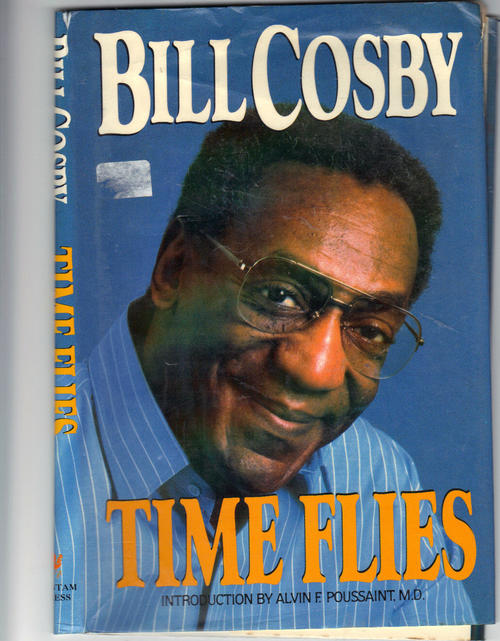We can all recall the most famous show in the 1980’s “The Cosby Show,”
right? Since that is the case, when we reminisce
on that humorous sitcom, we all with our great minds image that one person who
was the main character of the show: Bill Cosby, thus the title. While he has made television shows, comedies,
and films, not many people are aware that he is an author, writing the novel “Times
Flies,” the literature of which I am writing a summary and conducting a book
talk.
 As the plot begins, Bill Cosby first displays his collegiate
years at Temple University in the expedition of the novel. During the rising action, he compares his youthful
condition with his current condition, portraying different scenarios like how
he used to be able to clear 6’7” on a high jump bar when he now cannot even
pass 5’3” and how he used to only consume a quart of milk, bacon, eggs, and steaks
daily when he now has to eat foods like fish, skinless chicken, and vegetables,
putting lemon juice on the food to give him flavor he craved for when he was a
youth. After his numerous situations defining
the rising action, the climax of the novel evolves when he acknowledges the
fact that he is old and tries to adjust to his condition. He exhibits in the novel that his now-deceased
son Ennis can outrun him running three-quarters speed while Cosby running
seven-eighths speed, becoming aware that he needs to “accept what [he] is and not torture [himself] with
visions of what [he] used to be.” As the
action falls, he starts to correct his attitude towards an old man’s perception,
exemplifying “as [he has] grown older, [he has] studied people as they approached
[the] tarnished years so that… [he] could avoid unfortunate patterns of
behavior…” In result of his experience
on aging, Bill Cosby now lives the life of an usual elder, taking extensive naps,
devoting an immense amount of his time with his wife Camille, discussing the
weather, and refilling his medicine capsules weekly.
As the plot begins, Bill Cosby first displays his collegiate
years at Temple University in the expedition of the novel. During the rising action, he compares his youthful
condition with his current condition, portraying different scenarios like how
he used to be able to clear 6’7” on a high jump bar when he now cannot even
pass 5’3” and how he used to only consume a quart of milk, bacon, eggs, and steaks
daily when he now has to eat foods like fish, skinless chicken, and vegetables,
putting lemon juice on the food to give him flavor he craved for when he was a
youth. After his numerous situations defining
the rising action, the climax of the novel evolves when he acknowledges the
fact that he is old and tries to adjust to his condition. He exhibits in the novel that his now-deceased
son Ennis can outrun him running three-quarters speed while Cosby running
seven-eighths speed, becoming aware that he needs to “accept what [he] is and not torture [himself] with
visions of what [he] used to be.” As the
action falls, he starts to correct his attitude towards an old man’s perception,
exemplifying “as [he has] grown older, [he has] studied people as they approached
[the] tarnished years so that… [he] could avoid unfortunate patterns of
behavior…” In result of his experience
on aging, Bill Cosby now lives the life of an usual elder, taking extensive naps,
devoting an immense amount of his time with his wife Camille, discussing the
weather, and refilling his medicine capsules weekly.
In his novel “Time Flies,” Cosby explains his experience
on being 50 years old, not young. He
states how aging has affected his life, presenting many different section of his life in the novel and how he has dealt with aging in every circumstance
he depicts. In the section “Can You
Dig It” of Chapter 1, Cosby notes, “Suits... don’t go anywhere. I’m coming back.” While I laughed as much as I comprehended,
Bill Cosby indicates how when he entered his closet at that moment, he saw his sharp,
black suit hanging in the closet. The title
of the section, not to mention, serves as a different term compared to the
typical meaning; “Can You Dig It” refers to digging a grave, and when Cosby
glanced at his suit, his first thought was his age, which linked to his thought
of death. Additionally, in the
section of Chapter 2 “I Wonder as I Wander,” Cosby cites, “Roses are red/ my
Valiant is blue/ an A1 car/ in row A2.”
Whenever he said this quote, he had to think of a clever way to remember
where he parked while at the mall, characterizing how memory loss factors in
aging. Shockingly, Bill Cosby did not
even remember that poem when he
exited the mall to go home! Overall, his
aging traps him in a stage of delusion on a daily basis while he lives his
blessed life.
In summary, while the autobiography deserves a five star
rating, the novel outlines Bill Cosby’s life, describing his notable childhood
and adulthood eras that triggered in his “nifty-fifty” approach of his
life. He also emphasizes on his trials
and tribulations of mid-life: aches and pains, memory and eyesight loss, and
slow reflexes that he is witnessing on his adventure of aging. Generally, aging is not a laughing matter,
but with Cosby’s fun-filled charisma and attitude, he makes his experience of
aging envious to people, for they cannot deal with aging as calm as Cosby has
done.



